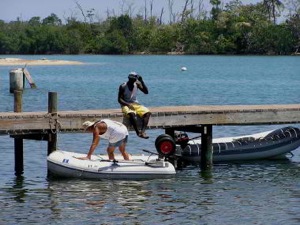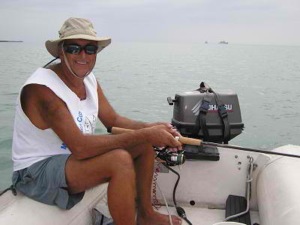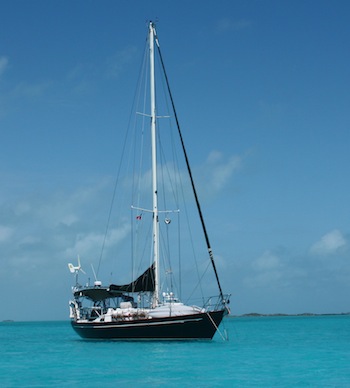The dinghy is the on the water version of the family car … when you’re anchoring out, it provides almost all your transportation to all the fun things you want to do … and sometimes to less fun things like laundry or jerry jugging diesel. Regardless, it’s critical that you remain in the dinghy! We’re heard horror stories of people falling out of dinghies and suffering serious injuries before the outboard prop can be stopped. We also know cruisers that have fallen, hit heads and drowned, so I take this post very seriously! PLEASE emphasize personal dinghy safety aboard your boat!
1. Carry life jackets in your dinghy. This is not a requirement in some countries and often cruisers leave the life jackets out, but it’s a good idea and they don’t take much space as compared to their value should you ever need them! We don’t usually wear them, but if it’s rough or if you’re landing through the surf, it’s not a bad idea if you’re not comfortable in the water.

2. Find a safe place to board and disembark the dinghy from your boat. Many boats have built special steps on the side if they don’t have a boarding/swim platform. Keep in mind you may need to board the dinghy when conditions are less than ideal — i.e. windy/rolly, waves slapping against the hull, etc. If you’re not comfortable with the setup you currently have, change it. Try a different ladder or step or use a different location.
3. Always remember the “one hand for yourself, one hand for stuff” rule. Never try to get out of the dinghy with both hands full!
4. Always use the red wrist band cord when operating the outboard. This cord attaches to the safety auto shutdown for the outboard so if the driver gets thrown free, it automatically stops the propeller. It also serves as a very quick way for the driver to yank the kill switch if a passenger gets thrown out of the dinghy.
5. Keep oars in the dinghy. If your outboard fails, you will need the oars to get back to your boat! And if the tide happens to be outgoing, you could drift a long way out to sea before anyone notices you’re gone if you have no way to propel the dinghy when the outboard takes a vacation!
6. We also carry a whistle, a bailing bucket (i.e. scoop cut from a plastic gallon vinegar jug) and a sponge in the dinghy.
7. It’s always a good idea to carry your dinghy anchor all the time. Make SURE it has the appropriate length of chain/rode for your cruising area. If your outboard quits, you can always drop the anchor giving you time to fix it. We’re not as good as we should be about this, but when we go snorkeling, we always have the anchor aboard.

7. The biggest personal safety tip of all … BE EXTRA CAUTIOUS WHEN BOARDING YOUR BOAT AFTER ATTENDING A CRUISERS COCKTAIL PARTY!!! We’ve known cruisers from Boot Key Harbor to The Swimming Pool/Holendes Cayes/San Blas Islands that have drowned when they accidentally fell and hit their heads getting out of the dinghy returning from a cocktail function. PLEASE be careful and safe!!!
Have I missed anything? Please leave comments and share! THX! Jan














I’ve often thought of somehow rigging a rod or pole from our big boat that extends over, past the swim step that you could hold onto while boarding the dinghy. Not quite sure how yet but I’ll figure something out.
Seems like it could be a great idea – if you figure it out, let us know what you did! We don’t have a swim platform to board from, so we can’t try it. 🙂 THX! Jan
Weheaded a dinghy lift made that folds down across the back of our transom and swim platform and we love it! If you want, we can send you a picture.
Yes, please send pictures. I’d love to see how it came out.
People are interested in your photo EBanda! We can’t use your dinghy concept because the Monitor Windvane across our transom would be in the way. 🙂 But if you can e-mail me a photo (contact info on the top of the page), I’ll post it on CC for all to see. 🙂 THX! Jan
Check out the windline boarding handles. It has a socket that you mount on the boat in a place where you can install the handle in the socket to give you a steady loop to hold onto when getting into or out of your tender.
Or look at FreedomLift.com as a way to get into the tender before it gets launched in the water..
Accidents could be prevented if people would be learning safety tips most especially when on water. This could save from suffering due to serious injuries that might be detrimental to their health.
… [Trackback]…
[…] Find More Informations here: commutercruiser.com/tips-for-personal-dinghy-safety/ […]…
Great reminders!! Thanks!!
In the Bahamas we always hear of 2-3 dinghys going “missing.” This is almost always due to folks poorly securing their knots and only using one line. Our rule is always/always (OK, almost always) tie the dinghy up with 2 lines, even if only stopping to visit someone for a couple minutes. Get into this great habit. It’s a real bummer to lose a dinghy.
Several years ago read about someone in dry Tortugas whose outboard quit and an offshore wind almost blew them to sea. You could die this way. We now carry a handheld & small anchor w/rode when in area where there is a sea on one side. You would not be the first dinghy carried out to sea and lost… with you in it. One step worse than your dinghy going to sea alone! Ed & Sue on Angel Louise
Very good post! We will be linking to this great post on our site. Keep up the good writing.